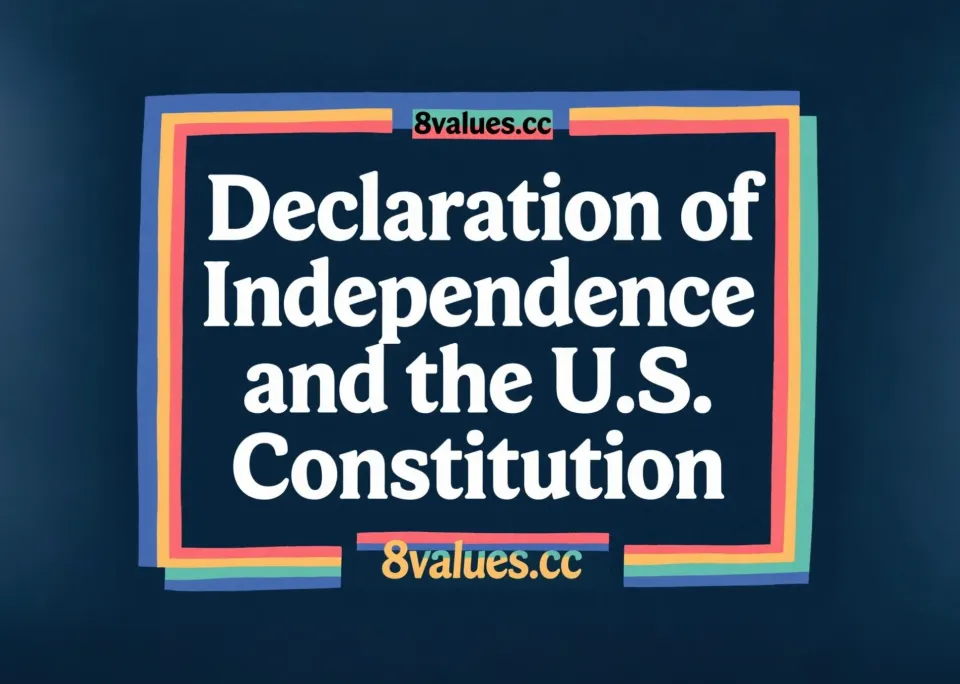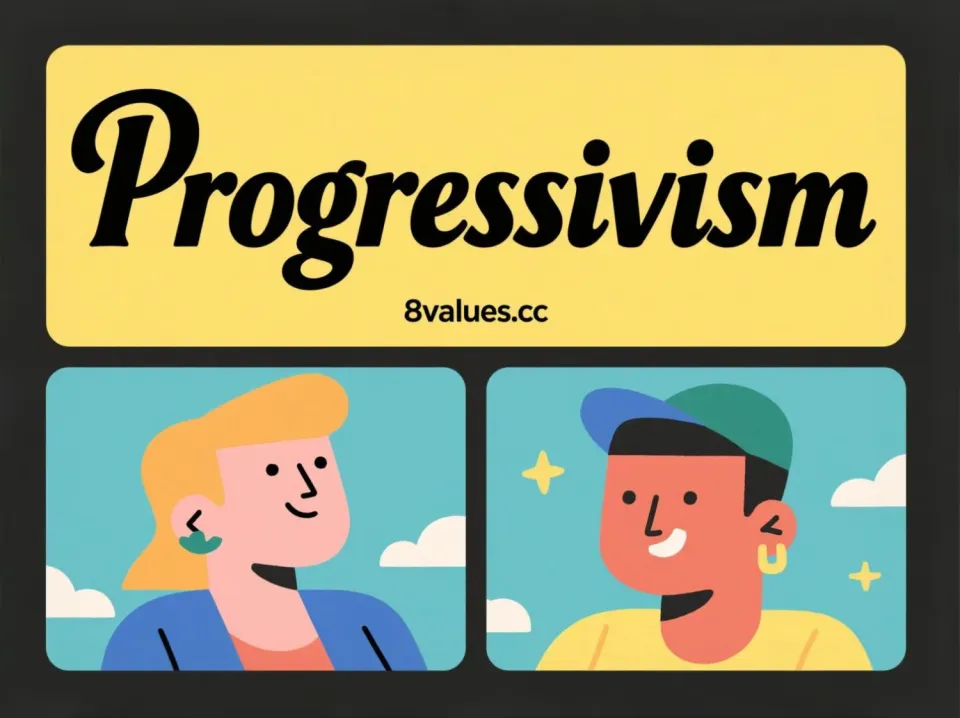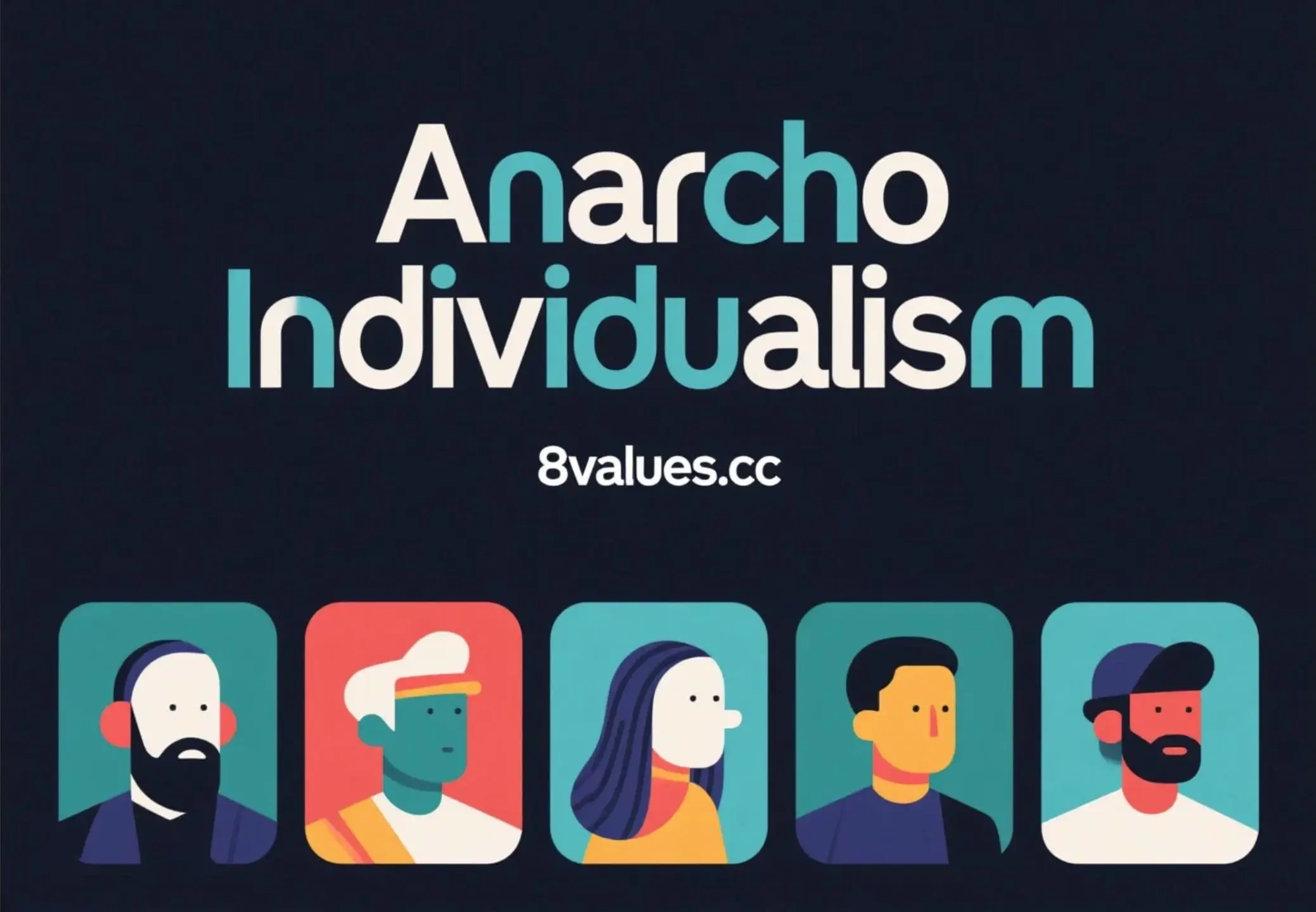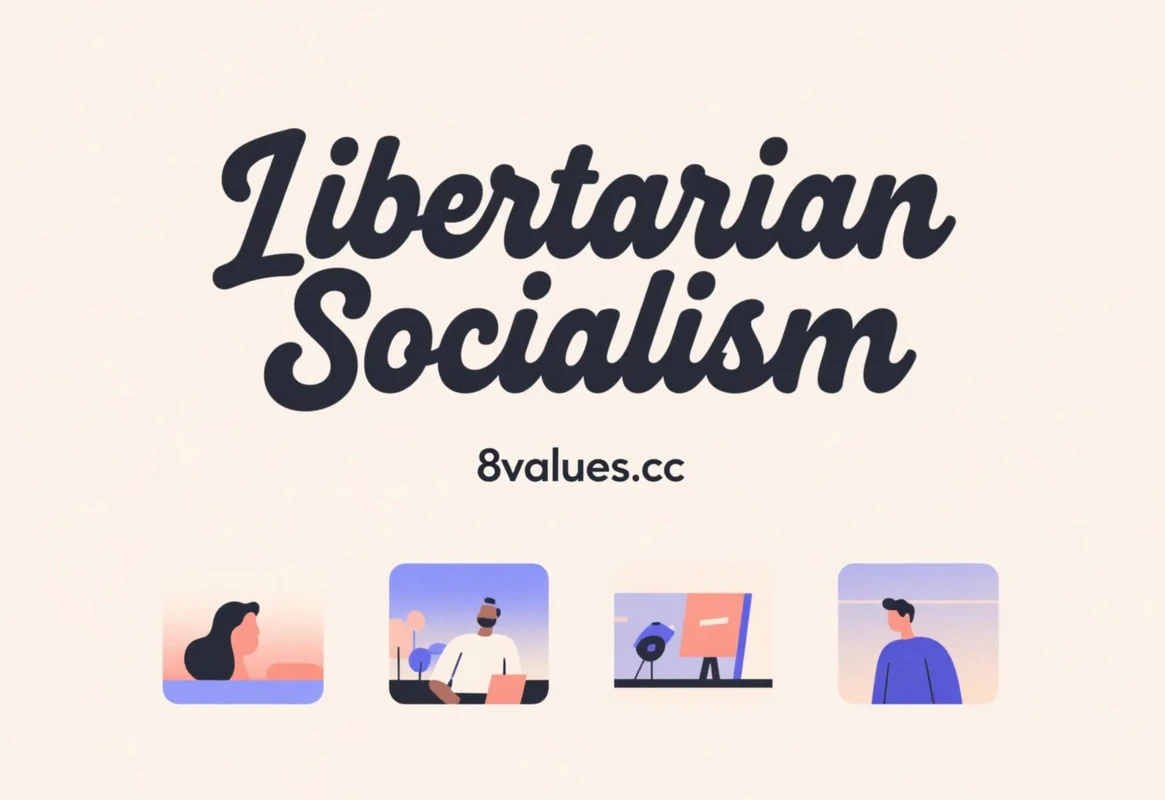Declaration of Independence and the U.S. Constitution: Political Values and Far-Term Impact of the Foundation Document
The Declaration of Independence is a political philosophy document that illustrates the goals and core values of the United States. It is not domestically binding, but serves as a guiding spirit when interpreting the US Constitution. Understanding the different roles and connections of these two foundational documents is the key to understanding American political philosophy and even evaluating individual political values. You can explore your own philosophy in depth with the 8values Political Values Propensity Test and refer to all ideological results.
During the founding of the United States, two documents had irreplaceable foundation status: the Declaration of Independence promulgated in 1776 and the US Constitution enacted in 1787. Together, they are known as the "Charters of Freedom" of the United States. However, there are significant differences in historical context, core role and legal status between the two documents. The Declaration of Independence is a revolutionary declaration that clarifies why the United States fights and the philosophical basis of the political community it desires to build; while the Constitution of the United States is the result of the revolution, laying the legal structure and governance framework for the new country.
The historical background and drafting process of the birth of the Declaration of Independence
After the end of the Seven Years of Britain and France in 1763, the British Parliament abandoned its policy of "salutary neglect" in colonies and instead tried to impose direct taxes on North American colonies, triggering an increasingly tense relationship between the colonies and the suzerain states. The colonists insisted that, as British subjects, they "have the right to all natural, basic, inherent, and indivisible rights possessed by their fellow countrymen in the United Kingdom." They cited the slogan "No Taxation without Representation" to oppose the Stamp Act passed by the British Parliament.
The colonial resistance escalated into a military conflict after the outbreak of the Battle of Lexington and Concord in 1775. Despite the outbreak of war, many people still hope to reconcile with Britain. However, in January 1776, the pamphlet "Common Sense" published by British immigrant Thomas Paine broke the silence. With his inflammatory language, Paine clearly advocated that North America should break completely with Britain, and he believed that "it is ridiculous to assume that a continent is permanently ruled by an island." The booklet was released on an unprecedented scale, greatly promoting the shift toward independence.
Adoption of the Resolution of Independence and Drafting of Declaration
Against the backdrop of high public opinion, representatives of the Continental Congress began to take action.
- Proposal of the Lee Resolution: On June 7, 1776, Virginia representative Richard Henry Lee proposed the famous Lee Resolution to the Continental Conference. The core of the resolution is: "These joint colonies are now, and should be, free and independent states; they release all obligations of allegiance to the British royal family and shall completely terminate all political ties with Great Britain ."
- Drafting Committee: Despite the time required for independence resolutions to win the authorization and unanimous agreement of the states, the Continental Conference appointed a five-member committee to draft a public declaration on June 11. The committee members include: Thomas Jefferson , John Adams , Benjamin Franklin, Robert R. Livingston and Roger Sherman .
- Jefferson's chief writer: John Adams took the initiative to recommend the young Virginian Thomas Jefferson's chief writer. Jefferson completed the first draft almost alone in a rental house in Philadelphia. The first draft was then reviewed and revised by the five-member committee (particularly Franklin and Adams), and the final version was modified by the Continental Conference as a whole , removing nearly a quarter of the content.
- Official adoption: On July 2, 1776, the Li Resolution was passed, marking a formal legal break with Britain. On July 4, 1776 , the Mainland Conference formally adopted the text of the Declaration of Independence, which clarified the reasons for breaking.
The Declaration of Independence's Political Philosophy Core and Spiritual Value
The Declaration of Independence was designed as a reasonable defense document for cutting ties with the UK, and it also acted as a transformative political philosophy literature .
The text of the declaration is usually divided into five parts: introduction, preface, accusation of the King of England, condemnation of the British people and conclusions.
Universal principles and “unspeakable truth” in the preface
The preface to the Declaration of Independence is the most important and far-reaching passage in American political thought. It goes beyond the specific legal debate on the British Constitution and resorts to the universal truth of "natural law" .
The core of the preface is "self-evident truths" :
- "We believe that these truths are self-evident: all men are created equal, and the Creator gives them several unalienable rights , including Life , Liberty and the pursuit of Happiness ."
- The declaration states that to safeguard these rights , the government was established among people, and its legitimate power originated from the consent of the governed .
- " Any form of government, as long as it undermines the above purpose, the people have the right to change or abolish it and establish a new government ."
These ideas embody the philosophical thoughts of the Enlightenment era, especially the theory of natural rights and social contracts of the British political philosopher John Locke . Jefferson himself admitted that the purpose of the declaration was not to propose new principles, but to "present the common sense of things before the world and win approval with concise words."
Complaints against the King of England and the declaration of independence
Most of the contents of the Declaration of Independence (about two-thirds) list in detail the 27 specific accusations made by the colonies against King George III of England. These accusations accused the king of "consistent abuse of power and robbery" and aimed at putting the colony under "absolute autocratic rule." The content of the accusation includes: refusal to approve laws that benefit the public interest, stationing troops in colonies, collecting taxes without consent, depriving juries of the right to trial, etc.
The concluding part of the declaration quotes the wording of the Li Resolution, solemnly declares that the United Colonials become free and independent states (Free and Independent States ). As independent countries, they have full power to declare war, peace, alliance, trade and do all acts and matters that other independent countries have the right to do. The signers supported this declaration “ with life, wealth and divine honor, mutual assurance and oath together ”, demonstrating their great courage to take risks of treason.
📢 A deep understanding of political stance: The concept of the Declaration of Independence, especially the emphasis on the legitimacy of the government comes from the "consent of the ruled", laid the foundation for modern democratic politics. Want to know your positioning in the contemporary political spectrum? Perform 8 values political ideology test now and explore your political values!
The essential difference between the Declaration of Independence and the US Constitution
Although the Declaration of Independence and the US Constitution are both founding documents of the United States, they have a clear division of labor in their role and status, which is a distinction between political philosophy and legal practice.
Philosophical Objectives and Legal Structure
| document | Core functions | Legal status | Issuance time |
|---|---|---|---|
| The Declaration of Independence (Declaration of Independence ) | The political philosophy document clarifies the goals, values and principles of the founding of the United States (such as equality, freedom, and agreed government). | Non-binding domestically . | July 4, 1776 (Adopted). |
| The US Constitution | Legal documents that determine the structure, authority and legal basis of the US government. It established a government system of checks and balances. | The supreme domestic law is the source of government power. | September 17, 1787 (adopted by the Constitutional Conference). |
| Bill of Rights | The constitutional amendment aims to protect citizens' personal freedom and specific restrictions on government power. | Part of the Constitution has the highest legal effect. | December 15, 1791 (Effective). |
The Declaration of Independence is a statement of "why independence" and it expresses the "an expression of the American mind". The US Constitution and its Bill of Rights are the blueprint for "how to govern" , which implements the commitment of "saving the safety and happiness of the people" in the Declaration of Independence by building government structures (such as weakening the governor, strengthening the legislature, increasing the frequency of elections).
Declaration as the guiding spirit of the constitutional interpretation
Although the Declaration of Independence itself is not domestic legal binding and cannot be directly cited in court to resolve specific complaints, it plays an important guiding role in legal interpretation. Politicians and jurists such as Abraham Lincoln believe that the U.S. Constitution should be interpreted under the spirit of the Declaration of Independence. That is, the core principles of the declaration—such as all beings being created equal and the consent of the ruled —provides high moral and political standards for the government established by the Constitution.
In the first decades after the revolution (the 1780s), the textual importance of the Declaration of Independence was ignored because its main purpose—declaration of independence—had been accomplished. During the Constitutional Convention, the language and concepts of the declaration were also hardly incorporated into the constitutional text . At that time, the Virginia Declaration of Rights, drafted by George Mason, was cited and imitated more frequently in state constitutions.
The Declaration of Independence has a profound impact on American governance philosophy
The political philosophy and philosophy of the Declaration of Independence have surpassed the original historical background over time and become the most " effective and consequential " text in American history.
Political Revival and Lincoln’s Moral Guide
It was not until the 1790s that with the rise of the first bipartisan politics in the United States, Jeffersonian Republicans began to fight for political advantages by promoting the importance of the Declaration of Independence and its author, Jefferson, thus reviving public interest in the Declaration of Declaration of Independence . Since then, the issue of the attribution of the author of the declaration has once become the focus of political controversy.
By the mid-19th century, the second paragraph of the Declaration—on equality and inalienable rights—was the core moral guide to American political discourse. During the abolition movement, Abraham Lincoln firmly believed that the “ all men are born equal ” in the declaration was a universal truth and a “standard maxim for free society” established for free society. Lincoln stressed that although complete equality had not been achieved during the colonial period, this principle set a goal for the United States and guided the United States to continue to improve . His Gettysburg Address cites the concept of the declaration, defining the United States as a "new nation that is bred in freedom and committed to the belief that everyone is born equal."
The banner for equal rights: the extension of the principle of equality
Because the United States Constitution and the Bill of Rights lacked a universal declaration of equality as the preamble to the Declaration of Independence, the declaration became a powerful weapon for the groups that later fought for civil rights.
- Women's Rights Movement: In 1848, the Declaration of Sentiments adopted by the Seneca Falls Convention imitated the style of the Declaration of Independence and clearly stated: " We believe that these truths are self-evident: all men and women are born equal ."
- Civil Rights Movement: In 1963, in his speech on "I Have a Dream" , Dr. Martin Luther King Jr. cited the creed in the manifesto, calling on the nation to fulfill its founding commitments and fulfill the "check" of "all men are born equal."
- LGBTQ+ Rights Movement: In 1978, activist Harvey Milk also cited the Declaration of Independence in his speech at the Gay Pride Celebration of San Francisco, emphasizing that the inalienable rights apply to all.
The ideal of freedom and equality claimed in the Declaration of Independence has continuously inspired generations of Americans to challenge injustice and strive to achieve their universal commitments in the later history.
Further reading and political insights
As a programmatic document for the United States to declare sovereignty externally and establish political ideals internally, the Declaration of Independence not only marks the beginning of a new era, but also provides a model for global democratic revolution. Its sovereignty principle, the concept of political equality , and the theory of people's right to have revolution are the cornerstone of American political ideology.
If you are interested in the formation of political philosophy and ideologies, we encourage you to learn more about political testing and how different ideologies affect our worldview.
- In-depth understanding: Explore 8 values Political values tendency test
- Explore different perspectives: Read other political tests
- Understanding Ideology: View 8values Detailed introduction to all results ideologies .
The text of the Declaration of Independence is still treasured in the National Archives in Washington, DC, as a permanent symbol of the founding spirit of the United States.
Document archives and dissemination of the Declaration of Independence
The dissemination of the Declaration of Independence went through multiple versions and stages, among which the "Dunlap broadside" and the "engrossed copy" were the most important.
- Dunlap broadside: On July 4, 1776, after the approval of the Continental Congress, it was immediately sent to the printer John Dunlap for about 200 copies overnight. This is the earliest publicly published text. George Washington ordered troops stationed in New York to read the document on July 9 to boost morale.
- Formal copy (Engrossed Copy ): On July 19, 1776, the Mainland Conference passed a resolution to clearly copy the declaration on parchment, and the title was added to the word " unanimous ". The transcript was handwritten by clerk Timothy Matlack and signed on August 2 mainly by 56 representatives. This formal copy is currently kept in the National Archives.
- Stone Facsimile: Because the original was blurred in the 19th century due to improper preservation, in 1823, then Secretary of State John Quincy Adams commissioned William J. Stone to produce an official copy of the copper engraving, which became the most familiar version we are today.
The Declaration of Independence plays a critical diplomatic role, showing the world that the colonies have no intention of reconciliation, allowing them to confirm official alliances with friendly foreign governments such as France and to obtain assistance in the War of Independence.
Excerpts from core citations :
The unanimous Declaration of the thirteen united States of America:
- “We believe that these truths are self-evident: all men are born equal , and the Creator gives them several inalienable rights , including the right to life, the right to freedom and the right to pursue happiness.”
- “To protect these rights, people establish governments among them, and the legitimate power of government comes from the consent of the ruled .”
- “Any form of government, as long as it undermines the above purpose, the people have the right to change or abolish it and to establish a new government.”






